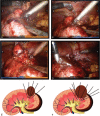Using a Harmonic Scalpel "Drilling and Clamping" Method to Implement Zero Ischemic Robotic-assisted Partial Nephrectomy: An Observation Case Report Study
- PMID: 26817867
- PMCID: PMC4998241
- DOI: 10.1097/MD.0000000000002349
Using a Harmonic Scalpel "Drilling and Clamping" Method to Implement Zero Ischemic Robotic-assisted Partial Nephrectomy: An Observation Case Report Study
Abstract
Robot-assisted partial nephrectomy (RAPN) has gradually become a popular minimally invasive nephron-sparing surgical option for small renal tumors. Ischemic injury should be minimized because it impacts renal function outcomes following partial nephrectomy. Herein, the authors detail the technique and present initial perioperative outcomes of our novel harmonic scalpel "drilling and clamping" method to implement zero-ischemic RAPN. The authors prospectively collected baseline and perioperative data of patients who underwent zero ischemic RAPN performed by our harmonic scalpel "drilling and clamping" method. From April 2012 to December 2014, a total of 19 consecutive zero ischemic RAPN procedures were performed by a single surgeon. For 18 of the 19 patients, RAPN using our harmonic scalpel "Drilling and Clamping" method was successfully completed without the need for hilar clamping. The median tumor size was 3.4 cm (range: 1.8-6.2); operative time was 3.2 hours (range: 1.9-4.5); blood loss was 100 mL (range: 30-950); and postoperative hospital stay was 4 days (3-26). One patient required intraoperative blood transfusion. Two patients had intra or postoperative complications: 1 was converted to traditional laparotomy because of massive bleeding, whereas another had postoperative stress ulcer. Pathology confirmed renal cell carcinoma in 13 patients (63.2%), angiomyolipoma in 6 patients: (31.5%), and oncocytoma in 1 patient (5.3%). Mean pre- and postoperative serum creatinine (0.82 mg/dL and 0.85 mg/dL, respectively), estimated glomerular filtration rate (84.12 and 82.18, respectively), and hemoglobin (13.27 g/dL and 12.71 g/dL, respectively) were comparable. The authors present a novel zero-ischemic technique for RAPN. They believe that this technique is feasible and reproducible.
Conflict of interest statement
The authors have no funding and conflicts of interest to disclose.
Figures





Similar articles
-
Zero-ischaemia robotic partial nephrectomy (RPN) for hilar tumours.BJU Int. 2011 Sep;108(6 Pt 2):948-54. doi: 10.1111/j.1464-410X.2011.10552.x. BJU Int. 2011. PMID: 21917096
-
Renal Functional and Perioperative Outcomes of Selective Versus Complete Renal Arterial Clamping During Robot-Assisted Partial Nephrectomy: Early Single-Center Experience With 39 Cases.Surg Innov. 2016 Jun;23(3):242-8. doi: 10.1177/1553350615610648. Epub 2015 Oct 12. Surg Innov. 2016. PMID: 26459499
-
Robotic partial nephrectomy with superselective versus main artery clamping: a retrospective comparison.Eur Urol. 2014 Oct;66(4):713-9. doi: 10.1016/j.eururo.2014.01.017. Epub 2014 Jan 25. Eur Urol. 2014. PMID: 24486306
-
Robot-assisted versus open partial nephrectomy: comparison of outcomes. A systematic review.Minerva Urol Nefrol. 2019 Apr;71(2):113-120. doi: 10.23736/S0393-2249.19.03391-5. Epub 2019 Mar 18. Minerva Urol Nefrol. 2019. PMID: 30895768
-
Intraoperative ultrasound in robot-assisted partial nephrectomy: State of the art.Arch Ital Urol Androl. 2018 Sep 30;90(3):195-198. doi: 10.4081/aiua.2018.3.195. Arch Ital Urol Androl. 2018. PMID: 30362686 Review.
Cited by
-
Ischemia Techniques in Nephron-sparing Surgery: A Systematic Review and Meta-Analysis of Surgical, Oncological, and Functional Outcomes.Eur Urol. 2019 Mar;75(3):477-491. doi: 10.1016/j.eururo.2018.10.005. Epub 2018 Oct 13. Eur Urol. 2019. PMID: 30327272 Free PMC article.
References
-
- Lau WK, Blute ML, Weaver AL, et al. Matched comparison of clinical practice radical nephrectomy vs nephron sparing surgery in patients with unilateral renal cell carcinoma and a normal contralateral kidney. Mayo Clin Proc 2000; 75:1236–1242. - PubMed
-
- Pahernik S, Roos F, Rohrig B, et al. Elective nephron sparing surgery for renal cell carcinoma larger than 4 cm. J Urol 2008; 179:71–74.discussion 74. - PubMed
-
- Gill IS, Aron M, Gervais DA, et al. Small renal mass. N Engl J Med 2010; 362:624–634. - PubMed
-
- Aron M, Haber GP, Gill IS. Laparoscopic partial nephrectomy. BJU international 2007; 99.5b:1258–1263. - PubMed
-
- Singh D, Rubenstein M, Gill IS. Laparoscopic partial nephrectomy. J Endourol 2005; 19.4:451–455. - PubMed
Publication types
MeSH terms
LinkOut - more resources
Full Text Sources
Other Literature Sources
Medical
Miscellaneous

